Managing your IT spending is not something to put on autopilot. You need to ensure you are getting the most out of your usage and not wasting money on unnecessary tasks. Managing IT spending can look different for every organization, but showback and chargeback are two popular methods businesses use today. As companies want more control and visibility over their spending, these two approaches can be extremely beneficial.
Before choosing which one is right for your business, learn about what they are and what advantages and drawbacks showback and chargeback provide.
What Is IT Showback?
A showback report provides businesses with data on how much IT resources the company has consumed and the costs versus their allocated budget. These reports can help businesses see their overall IT usage and pinpoint areas of opportunity regarding optimization or savings. Showback gives businesses three different ways of allocating and representing their costs.
Amortized costs allow businesses to spread out the expense of a specific resource instead of in one payment.
Blended costs are combined or averaged rates used to show the overall cost of a resource.
Unblended costs show a detailed, itemized breakdown of each resource’s costs.
Utilizing a showback allows businesses to track and report all of this data without the requirement of charging each department for their usage. This can be great for businesses that want to avoid assigning a cost to each department but still want transparency and tracking of their spending.
Advantages of Showback
- Transparency between departments and IT.
- No additional accounting process.
- Decreases the chance for errors.
- Provides detailed visibility of the costs of resources and gives multiple options for allocating costs.
- Make resource-based decisions and changes that positively impact costs and usage.
Disadvantages of Showback
- Without proper communication, motivating departments to adjust costs can be difficult.
- Reports are based on averages and can make it challenging to identify costs.
- Showbacks might become difficult to monitor on a regular basis.
What Is IT Chargeback?
This method of cost management and allocation focuses on IT departments charging individual units or departments for the resources they use. This usually starts with the IT department or business assigning a cost to each IT resource used by the individual departments and then charging them based on usage. This can be great for larger organizations that want to hold departments accountable for the resources they consume.
Industries such as healthcare, retail, manufacturing, and banking are seen to use the chargeback method to keep track of each department’s usage and correctly assign them the proper amount to ensure each department is getting a fair share.
Advantages of Chargeback
- This method ensures fairness among all the departments within the business.
- Encourages strategic use of resources and usage.
- Promotes cost-efficiency throughout the business.
- Accountability is raised, and transparency is of the highest importance.
Disadvantages of Chargeback
- Chargeback processes must be integrated into existing financial systems.
- The process to standardize chargeback processes among departments can be challenging.
- Financial true-ups are essential on a regular basis.
Choosing your IT cost management system is not a simple task, but it doesn’t need to be done alone. If you want to optimize your IT spending, don’t waste another moment. Contact the team at FinOps Oversight.

